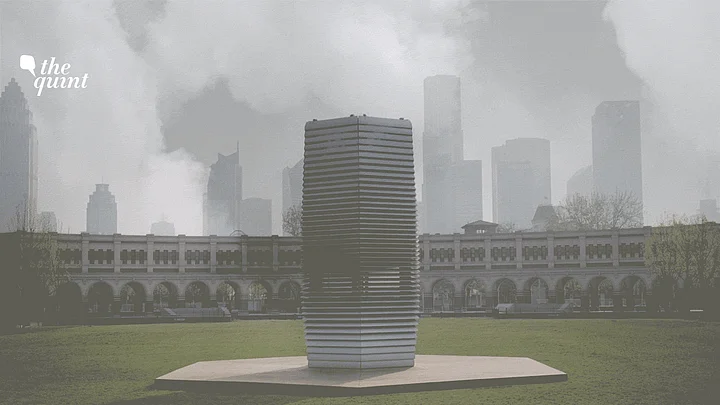(This story was first published on 24 August 2021 and is being republished from The Quint's archives ahead of Diwali as Delhi readies itself for another bout of severe smog.)
The Chief Minister of Delhi has inaugurated India’s first-ever smog tower in the heart of the city to help combat rising air pollution in the national capital. The 20-metre-long structure, which has been supposedly set up to improve air quality in a radius of around one kilometre, has been built at a cost of ₹20 crore.
And the optics look good. For a city that has been bogged down with smog every winter, being proactive, getting technology to fix the problem shows the government in the right light. After all the Bharatiya Janata Party (BJP) MP from East Delhi, Gautam Gambhir, did the same in another busy part of the city. These quick-fix solutions continue to find favour with our politicians despite repeated warnings by scientists that smog towers cant help clean the city’s air. Yet politicians often go for the solution that shows them as being proactive. The late William Safire, who wrote a column ‘On Language’ for the New York Times, observed, “When politicians fret about the public perception of a decision more than the substance of the decision itself, we’re living in a world of optics.”
Wicked Problems, Wicked Solutions
Safire was right. Inaugurating a smog tower just before the pollution season hits the city makes the Chief Minister look good. Decisions are not always taken for solutions, they are taken for political expediency. But people had high hopes from the Aam Admi Party (AAP) — their representatives are the only ones who show up to campaign meetings on Clean Air, they appear the most accessible when citizen groups petition them on the need to clean up Delhi’s air, and when you hear their spokesperson on television debates, it seems like they are seeking a genuine solution for the city.
What the AAP has assessed correctly is that along with bijli and paani (electricity and water), residents of Delhi also want saaf hawa (clean air), and that air pollution is an important political issue. But that’s where their engagement with this wicked problem ends. I have said in the past that air pollution is a wicked problem that deserves wicked solutions. Wicked solutions demand multi-sectoral, multi-agency responses. It requires political parties to work together to resolve a public health crisis. But in an environment of one-upmanship between political parties, it seems like the residents of Delhi are going to be treated to many smog towers with zero accountability on their efficacy.
The smog tower that was inaugurated in the heart of the capital is meant to be a ‘pilot’ project. But in his address, the Chief Minister has already labelled it as a big “milestone” in tackling air pollution.
What's the Obsession With Smog Towers?
And it’s not just the AAP or the BJP. Even the judiciary, which is nuanced in its response, has shown an unusual obsession with smog towers. In December 2019, the Supreme Court of India gave a warning to both the Central and Delhi governments to set up smog towers within three months.
Using smog towers to fight pollution seems like using sanitisers to fight COVID-19.
We know from the experience of the pandemic that in order to fight the silent public health crisis, interventions had to be made at several levels, from individual to systemic. Furthermore, it’s important that such interventions be adjusted on a time and number scale. Living with the pandemic has taught us that we need masks and sanitisers as an everyday intervention, lockdowns to tide over the immediate crisis, and a ramp-up of our healthcare system in the long run.
That’s exactly what we need with air pollution — short-term measures, such as restricting outdoor activity, can only help as emergency interventions. In the long run, we need policy measures that reduce emissions at source. These would require switching to cleaner fuel sources, better public transport with last-mile connectivity, a complete ban on garbage burning, among a plethora of interventions that scientists have cried themselves hoarse about. The solutions are clear, but our politicians and judiciary don’t want them. If we can flatten the pandemic curve, we can most certainly flatten the air pollution curve. So, let’s move beyond optics. Let’s talk science.
(Bahar Dutt is an award-winning environment journalist. This is an opinion piece. The views expressed above are the author’s own. The Quint neither endorses nor is responsible for them.)
